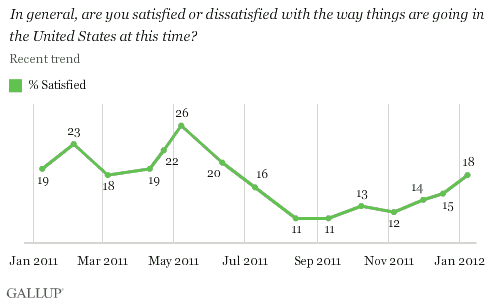PRINCETON, NJ -- Eighteen percent of Americans are satisfied with the way things are going in the United States today, a slight improvement from the latter half of 2011, when satisfaction levels ranged from 11% to 16%.

Though improved, the current figure remains well below 39%, which is the historical average satisfaction rating. Gallup first asked this question, its version of the "right track"/"wrong track" measure, in 1979.
Satisfaction has been consistently below average since 2005, spanning the last years of the Bush administration and the first years of the Obama administration. Satisfaction has not been as high as 40% since July 2005 and has not been at or above 50% since January 2004.
Satisfaction is one of several key measures, along with presidential approval and economic confidence, that help predict election outcomes. When Americans are largely dissatisfied with the way things are going in the country, incumbents and incumbent political parties are vulnerable to defeat.
Gallup has never found satisfaction lower in January of a presidential election year than it is now, though in several years -- including 1992, 1996, and 2008 -- satisfaction was relatively low. Of these years, only in 1996 did satisfaction improve over the course of the year, to 39%, a level high enough to help incumbent Bill Clinton win re-election.
Satisfaction levels also improved during 1988, but in other election years they declined at least slightly.

Economic Concerns Continue to Be Cited as Most Important Problem
Americans' economic angst is likely a major reason for their lower satisfaction with national conditions. Gallup's monthly update on the most important problem facing the country finds 66% mentioning some economic issue, though that percentage remains a bit lower than what Gallup measured as recently as November (76%).
The health of the economy in general (31%) and jobs or unemployment (26%) continue to rank as the top two specific issues Americans most often cite. Dissatisfaction with government is next, at 15%. The only other issues to receive at least 5% mention are the federal budget deficit and healthcare.
![What do you think is the most important problem facing this country today? [OPEN-ENDED] January 2012 results](http://content.gallup.com/origin/gallupinc/GallupSpaces/Production/Cms/POLL/kriiub3f4eobdabq5qfftg.gif)
The economy in general overtook the war in Iraq as the most important problem in 2008, and has ranked first or second on the list every month since; the economy and jobs have occupied the top two positions each month since December 2009.
Implications
Americans remain largely dissatisfied with the way things are going in the United States, though they are a bit more positive now than they have been in recent months. Their slightly more positive outlook may be a result of their slightly greater optimism about the economy.
Whether satisfaction continues to climb will be a key factor in determining President Obama's re-election fate. If it improves significantly, as it did in 1996, he may be a safe bet for a second term. But if it stays low, he could join Jimmy Carter and George H.W. Bush as one-term presidents denied a second term during a struggling economy.
Survey Methods
Results for this Gallup poll are based on telephone interviews conducted Jan. 5-8, 2012, with a random sample of 1,011 adults, aged 18 and older, living in all 50 U.S. states and the District of Columbia.
For results based on the total sample of national adults, one can say with 95% confidence that the maximum margin of sampling error is ±4 percentage points.
Interviews are conducted with respondents on landline telephones and cellular phones, with interviews conducted in Spanish for respondents who are primarily Spanish-speaking. Each sample includes a minimum quota of 400 cell phone respondents and 600 landline respondents per 1,000 national adults, with additional minimum quotas among landline respondents by region. Landline telephone numbers are chosen at random among listed telephone numbers. Cell phone numbers are selected using random-digit-dial methods. Landline respondents are chosen at random within each household on the basis of which member had the most recent birthday.
Samples are weighted by gender, age, race, Hispanic ethnicity, education, region, adults in the household, and phone status (cell phone only/landline only/both, cell phone mostly, and having an unlisted landline number). Demographic weighting targets are based on the March 2011 Current Population Survey figures for the aged 18 and older non-institutionalized population living in U.S. telephone households. All reported margins of sampling error include the computed design effects for weighting and sample design.
In addition to sampling error, question wording and practical difficulties in conducting surveys can introduce error or bias into the findings of public opinion polls.
View methodology, full question results, and trend data.
For more details on Gallup's polling methodology, visit www.gallup.com.
